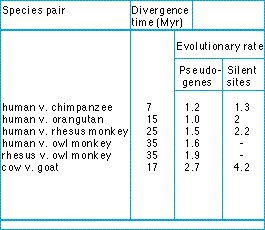Molecular evolution and neutral theory - What does the genetic evidence show?

The evolutionary rate of pseudogenes
A pseudogene is an example of non coding DNA. It is a sequence of bases in the DNA that clearly resembles the sequence of a known gene, but differs from it in some crucial respect and has no function. For example some pseudogenes cannot be expressed because they lack the promotors and introns needed for transcription.
It was originally thought that pseudogenes evolve faster than any other DNA and that their evolution was completely unconstrained: they would show pure neutral evolution in the pan neutralist sense. In this case, their rate of evolution would be a direct estimate of the total mutation rate. However, the latest evidence suggests that pseudogenes evolve at the same rate as silent base changes, and it is argued that evolution is probably to some extent constrained even in pseudogenes.
Table: pseudogenes evolve at about the same rate as silent base changes. Rates are expressed in numbers of base changes per 109 years. The comparisons are for various genes and pseudogenes in the globin gene family. Simplified from Li, Tanimura & Sharp (1987).
| Next |



